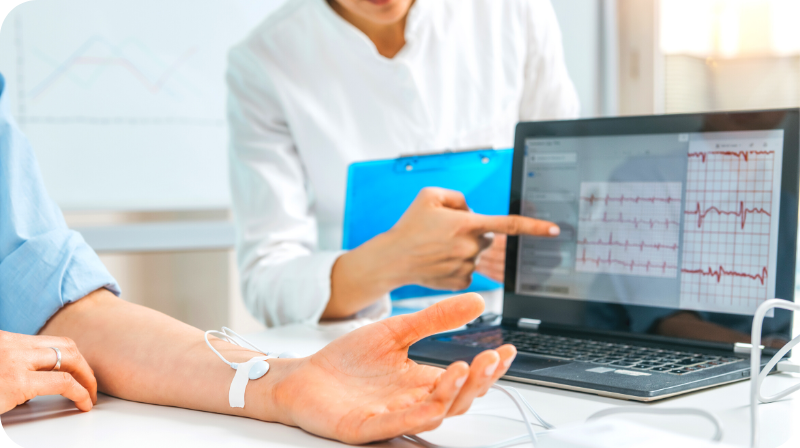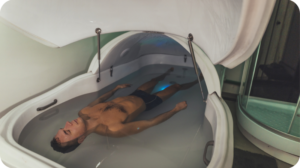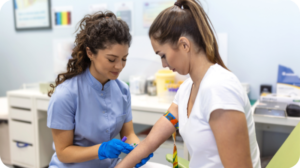What if you could use your own mental focus in concert with bodily processes to significantly impact both mental and physical disorders? Well, you can. It involves a harmless, non-invasive, drug-free technique known as biofeedback.

Biofeedback involves measuring various bodily functions, like respiration or heart rate, so that the patient can engage in real time to mentally adjust what are otherwise automatic physical responses. For instance, biofeedback can identify and isolate muscles that are contributing to headache pain, allowing the sufferer to consciously relax those muscles and alleviate some of the pain. The same process applies to panic attacks, muscle injury pain, and other conditions.
Biofeedback Practices
Although the concept is fairly basic, there are actually several biofeedback practices used by therapists. The choice of which to use in any given case is driven by the particular condition.
- EEG. This involves using sensors on the scalp that monitor brain wave activity. Sometimes called neurofeedback, the process is aimed at teaching a patient to control brain waves, most pointedly to retard the brain’s stress response that fuels so many psychological and brain-trauma conditions. This type of biofeedback can be used to treat a host of mental conditions and a few physical disorders as well. These include ADHD, anxiety, depression, PTSD, and even traumatic brain injuries.
- Breath. Respiratory biofeedback involves using chest bands to measure respiration patterns. The patient then uses the feedback to control breathing and, consequently, impact other bodily and mental functions. This is a powerful form of biofeedback that is primarily used to reduce situational stress. However, it can also improve sleep, increase energy levels, derail impulsive anger, and has been used to ease the symptoms of migraines and IBS.
- Heart rate variability feedback (HRVB). This can involve multiple sensors on the fingers, earlobes, and/or chest that monitor heart rate and how much it varies over a set time, with an electromyograph (ECG). A high amount of variability (defined as the variation in time between consecutive heart beats) is good. The patient uses ECG readings in an attempt to improve variability. This type of biofeedback is used to treat symptoms of depression, anger, and other mental health conditions, and can also improve heart health.
- Muscle control. This is a more specific version of biofeedback that involves sensors placed on specific muscles to monitor muscle contractions. The information gives the patient a tool to control involuntary muscle contraction. That can be incredibly useful in rehabilitation from musculoskeletal injuries, and in managing pain that muscle contractions may cause. This technique is increasingly considered an alternative to neuromuscular electrical muscle stimulation (NMES) in physical rehabilitation.
- Electrodermal skin response (ESRB). Used less often than other forms, this monitors sweat gland activity, offering the patient the opportunity to reduce that activity and lower anxiety and stress. Electrodes are connected to sweat gland locations and monitored by way of an electromyograph (EMG).
- Thermal biofeedback. As it sounds, this measures skin temperature to give the patient control over a small number of conditions that can cause small blood vessels to contract, raising the skin temperature. This type is used to reduce stress and anxiety, treat Raynaud’s Syndrome, and reduce the pain and severity of migraine headaches.
The Technology
Biofeedback therapy is often conducted in a clinical setting—like a physical therapy room or doctor’s office—using sophisticated computer programs, sensors, and monitors. However, there are also high-quality mobile sensors, as well as wearable biofeedback monitors. The type of biofeedback determines which you use.
Be aware, however, that there is a large and growing market of biofeedback devices for home use. Some of these are excellent and highly useful; others are quite the opposite. Some, like smart watches, include biofeedback apps as part of a suite of functions. Others, like skin-sensor bracelets and headbands, are solely meant to provide biofeedback.
Regardless of the technology, the place to start if you think biofeedback might be a helpful therapy is with your primary caregiver. That professional can provide a referral to the right practitioner for your case and condition. Look for a professional who is certified through an organization such as the Biofeedback Certification International Alliance (BCIA), or Applied Psychophysiology and Biofeedback (AAPB), an international society that includes an in-depth consumer guidance section on their website.





